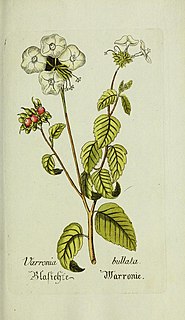
Serpentine soil is an uncommon soil type produced by weathered ultramafic rock such as peridotite and its metamorphic derivatives such as serpentinite. More precisely, serpentine soil contains minerals of the serpentine subgroup, especially antigorite, lizardite, and chrysotile or white asbestos, all of which are commonly found in ultramafic rocks. The term "serpentine" is commonly used to refer to both the soil type and the mineral group which forms its parent materials.

Chaetocarpus is a plant genus of the family Peraceae, formerly Euphorbiaceae, first described as a genus in 1854. Chaetocarpus species are trees or shrubs. There native to the Americas, Africa, and Asia. Some species are endangered.
- Chaetocarpus acutifolius(Britton & P.Wilson) Borhidi - Sierra de Moa in Cuba
- Chaetocarpus africanusPax - C Africa
- Chaetocarpus castanocarpus(Roxb.) Thwaites - SE Asia, Yunnan, Assam, Bangladesh, Sri Lanka
- Chaetocarpus cordifolius(Urb.) Borhidi - Cuba, Hispaniola, Jamaica
- Chaetocarpus coriaceusThwaites - Sri Lanka
- Chaetocarpus cubensisFawc. & Rendle - Cuba
- Chaetocarpus echinocarpus (Baill.) Ducke - Bolivia, Brazil
- Chaetocarpus ferrugineusPhilcox - Sri Lanka
- Chaetocarpus gabonensisBreteler - Gabon
- Chaetocarpus globosus(Sw.) Fawc. & Rendle - Jamaica, Cuba, Dominican Rep.
- Chaetocarpus myrsinitesBaill. - Bolivia, Brazil
- Chaetocarpus parvifoliusBorhidi - Cuba
- Chaetocarpus pearceiRusby - Bolivia
- Chaetocarpus pubescens(Thwaites) Hook.f. - Sri Lanka
- Chaetocarpus rabarabaCapuron - Madagascar
- Chaetocarpus schomburgkianus(Kuntze) Pax & K.Hoffm. - Colombia, Venezuela, 3 Guianas, NW Brazil

Calyptranthes is a genus of flowering plants in the family Myrtaceae. They are known commonly as lidflowers, spicewoods, and mountainbays. There are about 100 species.

Sideroxylon is a genus of trees in the family Sapotaceae described as a genus by Linnaeus in 1753. They are collectively known as bully trees. The generic name is derived from the Greek words σιδηρος (sideros), meaning "iron", and ξύλον (xylon), meaning "wood."

Erik Leonard Ekman was a Swedish botanist and explorer.
Auerodendron is a genus of plant in family Rhamnaceae.

Casasia is a genus of flowering plants in the family Rubiaceae. These shrubs or small trees occur on the Caribbean islands and in one case in Florida. Some of the ten accepted species were formerly placed elsewhere, e.g. in the related genip-tree genus (Genipa), in Gardenia or in Randia.

Exostema is a genus of flowering plants in the family Rubiaceae. It consists of trees and shrubs, endemic to the neotropics, with most of the species occurring in the West Indies.

Harpalyce is a genus of flowering plants in the legume family, Fabaceae. It belongs to the subfamily Faboideae.
Lantanopsis is a genus of Caribbean flowering plants in the sunflower family.

Chaptalia is a genus of flowering plants in the daisy family.

Cassine is a genus of trees, of the plant family Celastraceae.

Rondeletieae is a tribe of flowering plants in the family Rubiaceae and contains about 178 species in 8 genera. Its representatives are found from southern Mexico to northern South America and in the Caribbean.

Callicarpa (beautyberry) is a genus of shrubs and small trees in the family Lamiaceae. They are native to east and southeast Asia, Australia, Madagascar, southeast North America and South America.
Neobracea is a genus of plant in the family Apocynaceae first described as a genus in 1905. It was first given the name Bracea, but this turned out to be an illegitimate homonym. In other words, somebody else had already used it for another plant. Neobracea is native to Cuba and the Bahamas.
- Neobracea acunanaLippold - E Cuba
- Neobracea angustifoliaBritton - W Cuba
- Neobracea bahamensis(Britton) Britton - Bahamas, Cuba
- Neobracea ekmaniiUrb. - E Cuba
- Neobracea howardiiWoodson - EC Cuba
- Neobracea martianaBorhidi & O.Muñiz - E Cuba
- Neobracea susanninaBorhidi - E Cuba
- Neobracea valenzuelana(A.Rich.) Urb. - Cuba

Leucocroton havanensis is an endemic species to Cuba. It is located on serpentine soils and limestone rock in the western and central part of the country. It is an evergreen tree that has dioecious flowering, meaning the species has distinct male and female individuals. The plant only grows on a small serpentine island.

Mitracarpus is a plant genus in the coffee family Rubiaceae. Girdlepod is a common name for some species in this genus.
Tetralix is a genus of flowering plants in the mallow family Malvaceae, native to Cuba. Adapted to serpentine soils, they are nickel hyperaccumulators.

Varronia is a genus of flowering plants in the family Boraginaceae, found throughout Latin America, the Caribbean, and in the US states of Texas and Florida. They were resurrected from Cordia in 2007.
Schmidtottia is a genus of flowering plants in the family Rubiaceae, native to eastern Cuba. Adapted to serpentine soils, they are nickel hyperaccumulators.













